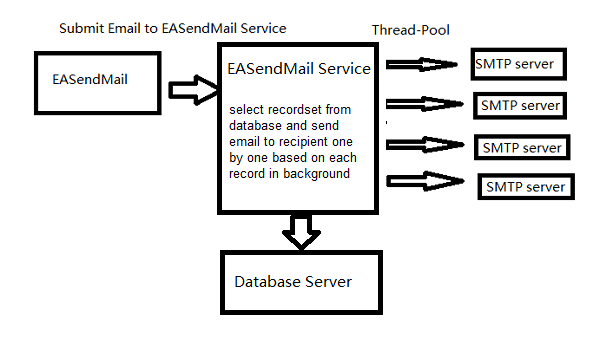Managed C++/CLI - Email queue with EASendMail Service - database¶
The following Managed C++/CLI example codes demonstrate how to pick recipients from database and
send email using email queue. In the example, we used C:\Program Files\EASendMailService\easendmail_demo.mdb
as sample MS Access Database.
SMTP Queue Service
EASendMail Service is a light and fast email delivery service which works with EASendMail SMTP Component to enable your application to send mass emails in background queue service.
Along with its ability to picking recipients from database in background and sending email in specified datetime, it eases your task in developing featured email application such as newsletter application. We strongly recommend you to use EASendMail Service with your ASP.NET/Web Application.
Important
To work with EASendMail Service, please download EASendMail and EASendMail Service at first, and then install both on your machine. If you are using web hosting service and you don’t have permission to install service on that server, EASendMail service is not suitable for you.
With EASendMail email queue feature, you do not have to code for multiple threadings. EASendMail Service can send email in background with multiple threadings automatically. You just need to adjust the maximum worker threads in EASendMail Service Manager to increase the performance. Please click here to learn more detail about EASendMail Service.
Another typical usage scenario is that most newsletter applications get recipient name and address from database. To simplify the task of developer, EASendMail provides a very powerful way to select recipients from database automatically.

Sections:
Installation¶
Before you can use the following codes, please download EASendMail SMTP Component and install it on your machine at first. Full sample proejcts are included in this installer.
Install from NuGet
You can also install the run-time assembly by NuGet. Run the following command in the NuGet Package Manager Console:
Install-Package EASendMail
Note
If you install it by NuGet, no sample projects are installed, only .NET assembly is installed. And you also need to get a trial license code from here instead of using “TryIt”.
Add reference¶
To use EASendMail SMTP Component in your project, the first step is Add reference
of EASendMail to your project. Please create or open your project with Visual Studio,
then go to menu -> Project -> Add Reference -> .NET -> Browse..., and select
Installation Path\Lib\net[version]\EASendMail.dll from your disk, click Open -> OK, the reference of EASendMail
will be added to your project, and you can start to use it to send email
in your project.

.NET assembly¶
Because EASendMail has separate builds for .Net Framework, please refer to the following table and choose the correct dll.
Separate builds of run-time assembly for .NET Framework 2.0, 3.5, 4.0, 4.5, 4.6.1, 4.7.2, 4.8.1, .NET 6.0, .NET 7.0, .NET 8.0, .NET Standard 2.0 and .NET Compact Framework 2.0, 3.5.
| File | .NET Framework Version |
| Lib\[net20|40|45|461|472|481]\EASendMail.dll |
Built with .NET Framework 2.0, 4.0, 4.5, 4.6.1, 4.7.2, 4.8.1
It requires .NET Framework 2.0, 3.5 or later version. |
| Lib\[net6.0|7.0|8.0]\EASendMail.dll |
Built with .NET 6.0, .NET 7.0, .NET 8.0
It requires .NET 6.0 or later version. |
| Lib\netstandard2.0\EASendMail.dll |
Built with .NET Standard 2.0
It requires .NET Standard 2.0 or later version. |
| Lib\[net20-cf|net35-cf]\EASendMail.dll |
Built with .NET Compact Framework 2.0, 3.5
It requires .NET Compact Framework 2.0, 3.5 or later version. |
MS Access x64 Driver¶
If your Windows is x64 bit, please download and install MS Access x64 Driver on your server and please change X-Data-Connection like this:
oMail->Headers->ReplaceHeader("X-Data-Connection",
"Driver={Microsoft Access Driver (*.mdb, *.accdb)}; " +
"Dbq=c:\\easendmail\\easendmail_demo.mdb;Uid=;Pwd=;");
MS Access Database x64 Driver Download
C++/CLI - Send email to queue service - database¶
The following example codes demonstrate sending email message using email queue + database.
In order to run it correctly, please change SMTP server, user, password, sender, recipient value to yours.
Note
To get full sample projects, please download and install EASendMail on your machine.
#include "stdafx.h"
using namespace System;
using namespace EASendMail;
int main(array<System::String ^> ^args)
{
try
{
SmtpMail ^oMail = gcnew SmtpMail("TryIt");
// Set sender email address, please change it to yours
oMail->From = "test@emailarchitect.net";
// Set email subject
oMail->Subject = "test email from Managed C++/CLI database queue";
// If you want EASendMail service to send the email after 10 minutes,
// use the following code.
// oMail->Date = System::DateTime::Now.AddMinutes(10);
// EASendMail will use the following connection to connect to the database,
// the syntax is same as ADO connection object.
oMail->Headers->ReplaceHeader("X-Data-Connection",
"Driver={Microsoft Access Driver (*.mdb)}; " +
"Dbq=c:\\easendmail\\easendmail_demo.mdb;Uid=;Pwd=;");
// EASendMail will select the fields by the following sql statement
// before sending email,
// then pick the recipient address from specified field.
oMail->Headers->ReplaceHeader("X-Sql-Select", "SELECT id, name, address FROM Recipients");
// pick "name" field as the recipient name and "address" field as
// the recipient address.
// you can also use {$var_srecord:fieldname} to pick any field
// in X-Sql-Select statement and put it to subject, bodytext, then EASendMail will
// replace it automatially.
oMail->Headers->ReplaceHeader("To", "\"{$var_srecord:name}\" <{$var_srecord:address}>");
oMail->Headers->ReplaceHeader("X-Rcpt-To", "{$var_srecord:address}");
// EASendMail service will execute the following sql statement on
// every email was sent successfully.
oMail->Headers->ReplaceHeader("X-Sql-OnSentSuccess",
"INSERT INTO sentlog (server, email) VALUES('{$var_server}', '{$var_rcptaddr}')");
// EASendMail service will execute the following sql statement on
// every email could not be sent.
oMail->Headers->ReplaceHeader("X-Sql-OnSentError",
"INSERT INTO errorlog(email, server, errorcode, errordescription)" +
" VALUES('{$var_rcptaddr}', '{$var_server}', '{$var_errcode}', '{$var_errdesc}')");
String ^s = "Hi {$var_srecord:name}, \r\n";
s += "this sample demonstrates how to send email using email queue.\r\n\r\n";
// {$var_srecord:address} will be replaced by EASendMail automatically.
s += "Your id in database is {$var_srecord:id}.\r\n\r\n";
s += "No matter how many recipients there are, EASendMail ";
s += "service will send the email in background.\r\n\r\n";
// {$var_srecord:id} {$var_srecord:address} {$var_srecord:name} in
// body text will
// be replaced by EASendMail automatically.
oMail->TextBody = s;
// Your SMTP server address
SmtpServer ^oServer = gcnew SmtpServer("smtp.emailarchitect.net");
// User and password for ESMTP authentication, if your server doesn't require
// User authentication, please remove the following codes.
oServer->User = "test@emailarchitect.net";
oServer->Password = "testpassword";
// Most mordern SMTP servers require SSL/TLS connection now.
// ConnectTryTLS means if server supports SSL/TLS, SSL/TLS will be used automatically.
oServer->ConnectType = SmtpConnectType::ConnectTryTLS;
// If your SMTP server uses 587 port
// oServer->Port = 587;
// If your SMTP server requires SSL/TLS connection on 25/587/465 port
// oServer->Port = 25; // 25 or 587 or 465
// oServer->ConnectType = SmtpConnectType::ConnectSSLAuto;
Console::WriteLine("start to send email to database queue ...");
SmtpClient ^oSmtp = gcnew SmtpClient();
oSmtp->SendMailToQueue(oServer, oMail);
Console::WriteLine("email was sent to queue successfully!");
}
catch (Exception ^ep)
{
Console::WriteLine("failed to send email with the following error:");
Console::WriteLine(ep->Message);
}
return 0;
}
TLS 1.2 protocol¶
TLS is the successor of SSL, more and more SMTP servers require TLS 1.2 encryption now.
If your operating system is Windows XP/Vista/Windows 7/Windows 2003/2008/2008 R2/2012/2012 R2, you need to
enable TLS 1.2 protocol in your operating system like this:
Enable TLS 1.2 on Windows XP/Vista/7/10/Windows 2008/2008 R2/2012
Appendix
- Send Email in Managed C++/CLI - Tutorial
- EASendMail SMTP Component SDK
- Process Bounced Email (Non-Delivery Report) and Email Tracking
- Bulk Email Sender Guidelines
- Work with Email Queue
Comments
If you have any comments or questions about above example codes, please click here to add your comments.
